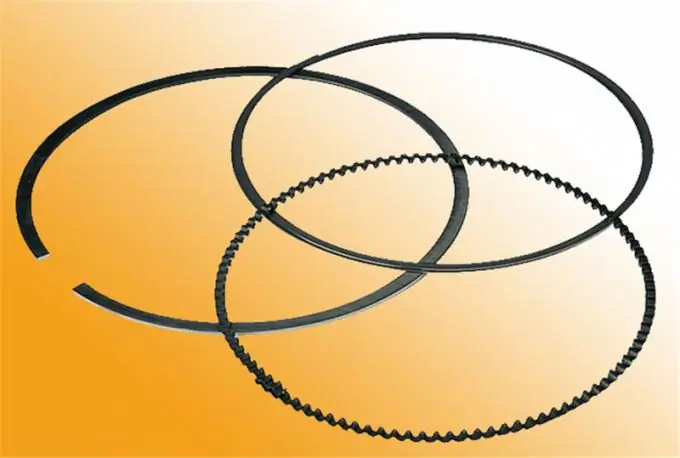- Author Maria Gibbs [email protected].
- Public 2023-12-16 03:05.
- Last modified 2025-01-22 17:47.
Fifteen to twenty years ago, the problem of buying piston rings was very acute. Now the range of spare parts includes all possible parts down to the smallest. However, there was a problem in choosing the correct replacement parts. It is the quality and reliability of piston rings and other parts of the cylinder-piston group that radically affect the service life of the engine after repair.

Instructions
Step 1
Currently, piston rings of several nominal sizes are produced for cars, each of which accounts for 1-2 repair rings. One of the best materials is special ductile iron with high antiwear properties. Not all domestic factories use this material, so pay attention to it first.
Step 2
The oil scraper rings are available in chrome and non-chrome. The third type - steel rings with a spring element - select only for installation when repairing the engine. They are only of nominal size. Chrome rings are more suitable for engines with higher compression ratios and more loaded operating conditions. To distinguish a non-chrome ring from a chrome ring, pay attention to the protrusions. In non-chrome plated, they are asymmetrical. And in color, both are the same.
Step 3
Pay attention to the expansion springs. They must have a variable pitch of winding turns and a ground surface along the outer diameter and ends. Other options for rings can either be fake, or be made on cheap equipment and have a low resource. Check the profile and height of the tabs. If they are absent or barely noticeable, then the rings are used.
Step 4
Steel oil scraper rings are widely used on foreign cars due to their long service life, lower weight and cost. If possible (their use is limited), purchase such for your domestic car.
Step 5
When selecting compression rings, feel for a chamfer on one or both sides of the outer diameter of the ring. Low-quality parts do not have such a chamfer. Another feature of high quality parts is the brightened and rounded ends. The chrome plating of the compression rings creates a matte finish. You can use it to distinguish them from non-chrome-plated rings, which have a steel luster. Use a micrometer to check the nominal and repair size of the ring to ensure that it is safe from counterfeiting.
Step 6
Pay attention to the markings on the rings. The factory mark indicating the size and company is automatically placed in a strictly fixed place. There are always deviations from the established place on a fake. Also, make sure the rings are packaged in their original packaging in sachets of 3. The bag should indicate: kit number, engine model and ring size. The box must contain the number of cylinder kits-bags corresponding to the number of engine cylinders for which they are intended. All inscriptions should be applied in one font, there should be an OTK stamp, the gluing points of the box should be in strictly defined places.
Step 7
For orientation in the assortment of piston rings, use the technical documentation for the repair and spare parts of the engine. It indicates the required piston ring dimensions required for a specific repair of the power unit.
Step 8
By installing short-life rings, you will reduce cylinder bore wear and extend engine life. But at the same time, every 30-40 thousand km will have to completely disassemble the engine and change the rings. Durable rings will last 150-200 thousand km. After such a run, in both cases, you will have to grind the crankshaft, change its liners and make minor repairs to the cylinder-piston group. Calculate how much it will cost to disassemble and assemble the engine every 30-40 thousand.km over the 200,000th run and decide whether such care of the engine is worth the financial and labor costs.






